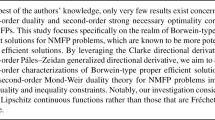Abstract
Using a dual method for solving linear fractional programming problems, we propose an approach to find optimal solutions of linear countable semi-infinite fractional programming problems via optimizing sequences. Duality theorems are established. A dual scheme for solving linear countable semi-infinite fractional problems is proposed. Examples are provided.
Similar content being viewed by others
References
Anderson, E.J., Nash, P.: Linear Programming in Infinite Dimensional Spaces. Wiley, Great Britain, England (1987)
Asham, H., Kahn, A.: A complete algorithm for linear fractional programming. Comput. Math. Appl. 20(7), 11–23 (1990)
Bazalinov, E.B.: Linear Fractional Programming: Theory. Methods. Applications and Software. Springer-Science+Business Media, B. V. (2003)
Chadha, S.S., Chadha, V.: Linear fractional programming and duality. Cent. Eur. J. Oper. Res. 15(2), 119–125 (2007)
Charnes, A., Cooper, W.W.: Programming with linear fractional functionals. Nav. Res. Log. Q. 9(3–4), 181–186 (1962)
Cooke, R.G.: Infinite Matrices and Sequence Spaces. Macmilan and Co. Limited, London (1950)
Crouzeix, J., Ferland, J.A., Schaible, S.: Duality in generalized linear fractional programming. Math. Program. 27, 342–354 (1983)
Dinkelbach, W.: Die maximierung eines quotienten zweier linearer funktionen unter linearen nebenbedingungen. Probab. Theory Relat. Fields 1(2), 141–145 (1962)
Gabriel, J.R., López-Martínez, R.R., Lerma, O.H.: The lagrange approach to infinite linear programs. Sociedad de Estadistica e Investigacidn Operativa 9(2), 293–314 (2001)
Ghate, A.: Robust optimization in countably infinite linear programs. Optim. Lett. 10, 847–863 (2016)
Ghate, A., Smith, R.L.: Characterizing extreme points as basic feasible solutions in infinite linear programs. Oper. Res. Lett. 37, 7–10 (2009)
Goberna, M.A., Lopez, M.A.: Linear Semi-Infinite Optimization. Wiley, Chichester, England (1998)
Hettich, R., Kortanek, K.O.: Semi-infinite programming: theory, methods, and applications. SIAM Rev. 35(3), 380–429 (1993)
Hu, H.: One phrase algorithm for semi-infinite linear programming. Math. Program. 46, 85–103 (1990)
Kornbluth, J.S.H., Stuer, R.E.: Multiple objective linear fractional programming. Manag. Sci. 27(9), 1024–1039 (1981)
Nayak, S., Ojha, A.K.: Solution approach to multi-objective linear fractional programming problem using parametric functions. Opsearch 56, 174–190 (2019)
Panday, P., Punnen, A.P.: A simple algorithm for piecewise-linear fractional programming problems. Eur. J. Oper. Res. 178, 343–358 (2007)
Seshan, C.R.: On duality in linear fractional programming. Proc. Indian Acad. Sci. Math. Sci. 89, 35–42 (1980)
Sharkey, T.C.: Infinite Linear Programs. Wiley Encyclopedia of Operations Research and Management Science. Wiley, In book (2011)
Sharma, I.C., Swarup, K.: On duality in linear fractional functionals programming. Math. Methods Oper. Res. 16(3), 92–100 (1972)
Shivakumar, P.N., Sivakumar, K.C., Zhang, Y.: Infinite Matrices and Their Recent Applications. Springer, Switzerland (2016)
Singh, S., Haldar, N.: A new method to solve bilevel quadractic linear fractional programming problems. Int. Game Theory Rev. 17(2), 1540017 (2015)
Sivakumar, K.C., Swarna, J.M.: Explicit solvability of dual pairs of infinite linear programs. Opsearch 42(3), 288–296 (2005)
Son, T.Q.: On a duality scheme in linear fractional programming. Nonlinear Anal. Forum 11(2), 137–145 (2006)
Son, T.Q., Khoa, H.: A note on dual scheme of a linear fractional programming problem. J. Nonlinear Anal. Optim. 8, 1–6 (2017)
Stancu-Minasian, I.M.: Fractional Programming. Kluwer, Dordrecht (1997)
Stancu-Minasian, I.M.: A ninth bibliography of fractional programming. Optimization 68(11), 2125–2169 (2019)
Swarup, K.: Linear fractional functions programming. Oper. Res. 13(6), 1029–1036 (1965)
Tantawy, F.S.: A new method for solving linear fractional programming problems. Aust. J. Basic Appl. Sci. 1(2), 105–108 (2007)
Tantawy, F.S.: A new procedure for solving linear fractional programming problems. Math. Comput. Model. 48, 969–973 (2008)
Verma, R.U.: Semi-Infinite Fractional Programming. Springer, Singapore (2017)
Acknowledgements
The authors are grateful to one of the anonymous referees for his valuable suggestions and remarks which helped us to improve the quality of the paper. The first author was supported partially by Vietnam National Foundation for Science and Technology Development (NAFOSTED) under grant number 101.01-2020.09. The second author was supported by the National Research Foundation of Korea (NRF) Grant funded by the Korean Government (NRF-2019R1A2C1008672).
Author information
Authors and Affiliations
Corresponding author
Additional information
Publisher's Note
Springer Nature remains neutral with regard to jurisdictional claims in published maps and institutional affiliations.
Appendix
Appendix
In this part, we mention some duality theorems for linear fractional programming problems introduced in [18, 26] and refined in [24]. For convenience, the theorems are restated for \(\mathrm{(P_k)}\) and \(\mathrm{(D_k)}\) without proofs except Theorem A.2.
Theorem A.1
(Weak duality) One has
Theorem A.2
(Strong duality) If \(\bar{x}_k\) is an optimal solution of \(\mathrm{(P_k)}\) then there exists an optimal solution \((\bar{u}_k,\bar{v}_k)\) of \(\mathrm{({D}_k)}\) and
Proof
Let \(\bar{x}_k\) be an optimal solution of \(\mathrm{(P_k)}\). By Dinkelbach transformation and by setting \(\displaystyle {\bar{\lambda }=\frac{c^T\bar{x}_k+c_0}{d^T\bar{x}_k+d_0}}\), we have the following linear problem:
It is easy to verify that \(\bar{x}_k\) is also an optimal solution of \(\mathrm{(LP_k)}\) and its optimal value is 0, (see [3, Theorem 3.2]). According to dual scheme in linear programming, we obtain the dual problem of \(\mathrm{(LP_k)}\):
Note that the optimal value of \(\mathrm{(LD_k)}\) is 0 and \(\mathrm{(LD_k)}\) must have an optimal solution \(\bar{v}^*\ge 0\). Hence,
Choose \(\bar{u}_k= \bar{x}_k\) and \(\bar{v}_k=(d^T\bar{x}_k+d_0) \bar{v}^*\). We claim that \((\bar{u}_k,\bar{v}_k)\) is an optimal solution of \(\mathrm{(D_k)}.\) Obviously, the conditions (6) and (7) hold for \({\bar{u}}_k\) and \({\bar{v}}_k\). We need to verify (4) and (5). Since
the condition (4) holds. Next we verify (5). Multiplying both sides of (16) by \((d^T\bar{x}_k+d_0)>0\) and noting that \(\bar{\lambda }(d^T\bar{x}_k+d_0)=(c^T\bar{x}_k+c_0),\) we get
Hence,
Thus, \(({\bar{u}}_k, {\bar{v}}_k)\) is a feasible solution of \(\mathrm{(D_k)}\). Since \(F(\bar{x}_k)=F(\bar{u}_k)=I(\bar{u}_k, \bar{v}_k)\), the pair \((\bar{u}_k, \bar{v}_k)\) is an optimal solution of \(\mathrm{(D_k)}\). The proof is complete. \(\square \)
Theorem A.3
(Converse duality) If \((\bar{u}_k,\bar{v}_k)\) is an optimal solution of \(\mathrm{({D}_k)}\) then there exists an optimal solution \(\bar{x}_k\) of \(\mathrm{(P_k)}\) such that the equality (15) holds.
Theorem A.4
One has
where \(\mathrm{Pr}_{\mathbb {R}^n}{({Y}_k)}= \{ u_k \in \mathbb {R}^n \mid (u_k,v_k)\in {Y}_k\},\) \({Y}_k\) is the feasible set of \(\mathrm{(D}_k)\) and \(\mathrm{Sol(P_k)}\) is the solution set of \(\mathrm{(P_k)}.\)
Corollary A.1
The solution set of \(\mathrm{(P_k)}\) is nonempty if and only if the feasible set of \(\mathrm{({D}_k)}\) is nonempty.
Rights and permissions
About this article
Cite this article
Son, T.Q., Kim, D.S. A dual scheme for solving linear countable semi-infinite fractional programming problems. Optim Lett 16, 575–588 (2022). https://doi.org/10.1007/s11590-021-01735-y
Received:
Accepted:
Published:
Issue Date:
DOI: https://doi.org/10.1007/s11590-021-01735-y




